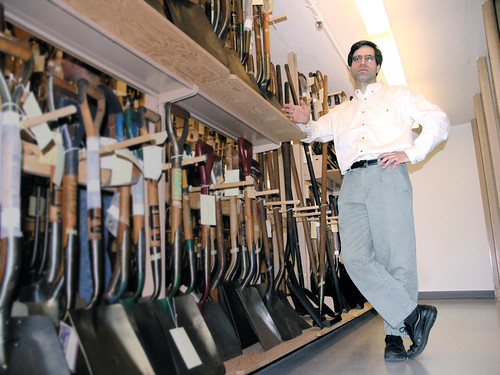
cc licensed ( BY NC SD ) flickr photo shared by misterbisson
“Curating” web content has been a medium flying buzzword over the last year. I’m not going to wade into the definitions or the tension from the museum quarter. For irony, on searching flickr cc images for “curator”, the image above is of a curator at the Shovel Museum (did you know there was such a thing?). There is something about shovels….
What is this “web curating”? There is curated.by, Qrait— described as:
A realtime curation platform designed to fulfill the needs of content curators and reduce information overload for the rest of us…. Real-time filtering isn’t curation, it’s filtering. Qrait lets you combine real-time filtering and your own personal touch to create something of value that people trust.
If I understand correctly, it is filtering plus picking. Again I reserve no judgement about whether this is or not curation, but it is an interesting new twist on mashing up social media content, or glueing them together.
This morning I took a play with another one, Storify. Like a modern tool, you create accounts through an exiting account (authenticating in twitter). You get to pick and chose content from your twitter stream, twitter searches, facebook, flickr, YouTube, RSS, slideshare, and even embedding content ordinary URL.
I found the search tools a bit under developed- there where tweets I found by scrolling back in time that did not come up on search. In flickr, I’d like to reach into sets, or search within a particular user’s stream (e.g. my own). But that’s an aside.
I found it easy to assemble strings of things, and I can augment them with text box descriptions. And you can re-order them.
I am thinking I can use this as an example within 50+ Web 2.0 Ways to Tell a Story. On using the tool, it lends itself more to current or in near time action, so you can pluck things off of a stream. It would be ideal as a tool to build an archive of the best bits out of a conference or event. You can also invite co-authors to help do the work.
The other neat thing is when you publish, it offers the option to send a link to twitter, and even notify the people mentioned in the tweets you pulled.
I could only give this a whirl by creating something. I spun my wheels for a while, but thought with a few recent live audio streams on ds106 radio, I decided to find content I could do related to people (me, @Scottlo, @mikhailg) who had recently brought their Mom’s into the live stream.
It took maybe 15 minutes to assemble– and here it goes, as you can also embed it (see below- note, it would maybe be more useful in an iframe, as it is long)
I’m going to give it a closer look, but would like to hear what people think of this. It’s quasi evolutionary step from the process of creating/sharing in a personal space (blog) to doing blog-like things in multiple places, but being able to assemble some of it together (not a total mix).

cc licensed ( BY NC SD ) flickr photo shared by Minneapolis Institute of Arts
There is something there there.


CogDogBlogged: Quick Play with Storify (trying to avoid the “c” word) http://bit.ly/eNJ7tr
This comment was originally posted on Twitter
New Post: Quick Play with Storify (trying to avoid the “c†word): cc licensed ( BY NC SD ) flickr pho… http://bit.ly/dN3KAv by @cogdog
This comment was originally posted on Twitter
Quick Play with Storify (trying to avoid the “c†word) http://bit.ly/dN3KAv
This comment was originally posted on Twitter
Quick Play with Storify (trying to avoid the “c†word) http://t.co/7f0eeHp
This comment was originally posted on Twitter